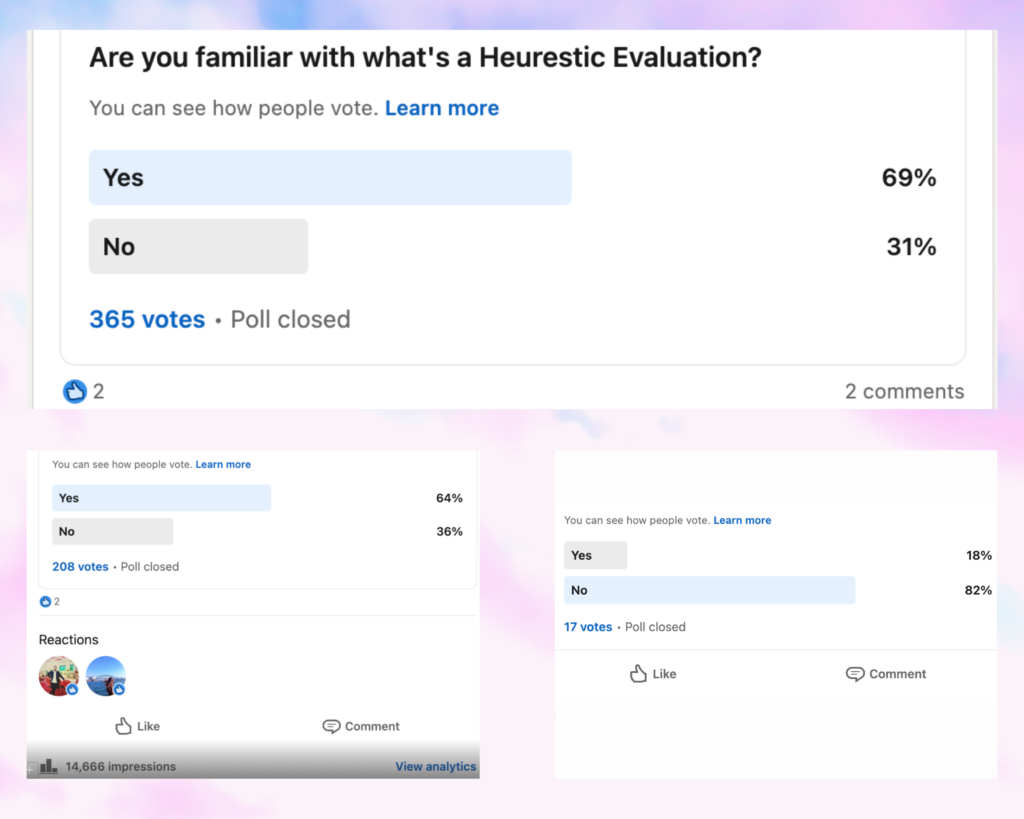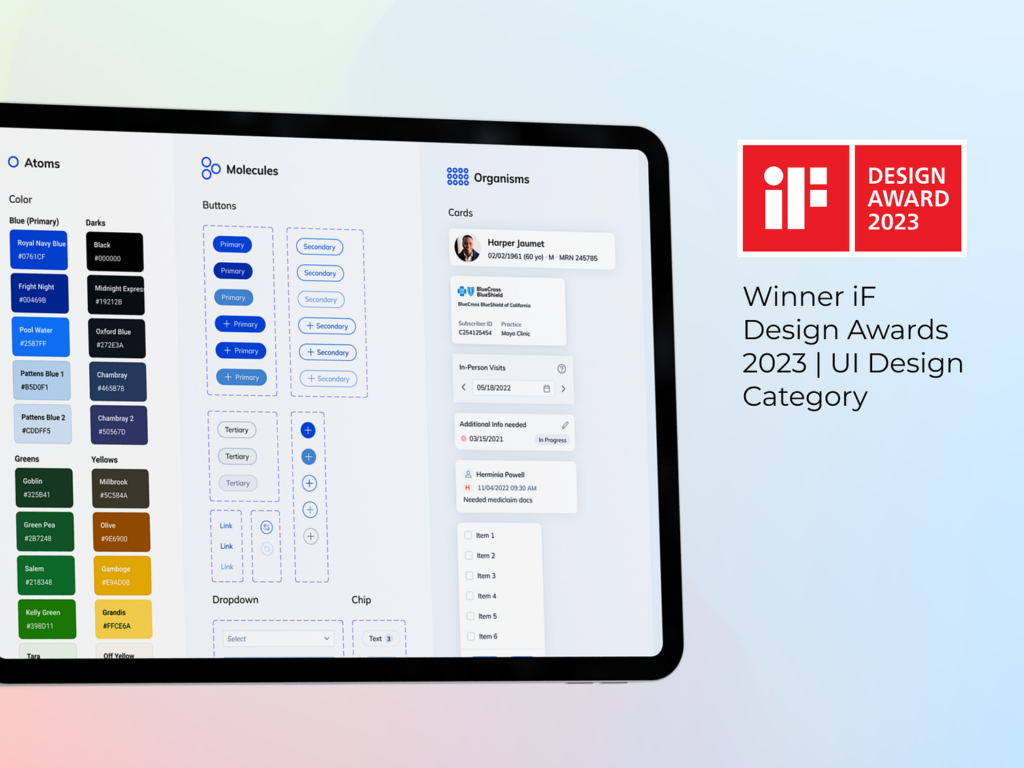It was back in 1994 that Jakob Nielsen defined and outlined the importance of heuristic evaluation for digital products –
Heuristic evaluation is a usability engineering method for finding the usability problems in a user interface design so that they can be attended to as part of an iterative design process. It involves having a small set of evaluators examine the interface and judge its compliance with recognized usability principles (the “heuristics”). Source
Cut to almost 30 years later, and there still remains some ambiguity in product teams about what a heuristic evaluation is and how it can benefit them.

What is a Heuristic Evaluation?
Heuristic evaluation is a usability inspection method in which expert evaluators apply a set of predefined usability principles, known as heuristics, to assess the user interface of a software product. These heuristics, based on established guidelines and best practices, provide a framework for evaluating the usability and user experience of a system. They help uncover usability problems, identify areas of improvement, and offer actionable recommendations to enhance the product’s design.
Some criteria applied in a heuristic evaluation include –
- Checking if users are in control – finding out if your users understand the system and can rectify erroneous actions.
- Make use of real-world jargon and ensure that users can understand the content.
- Ensure that there is consistency in labels, icons, layouts, etc.
Seasoned heuristic evaluators determine a product’s usability by going through a checklist to find flaws in the design. These flaws are then rated as per their severity and impact on the user experience so that designers can rectify them.
So, to clarify, a heuristic evaluation can be conducted with any set of heuristics. For example, the usability of an interface can be assessed based on usability heuristics — a set of high-level guidelines based on an understanding of human behavior, psychology, and information processing.
Some of the most common usability heuristics include,
Visibility of system status: The user should always be aware of the status of the system. This includes providing feedback on actions, errors, and progress.
Match between system and the real world: The system should be designed to match the real world as closely as possible. This includes using familiar terminology and concepts.
User control and freedom: The user should be able to control the system and be free to explore it. This includes providing undo/redo functionality and allowing users to customize the interface.
Error prevention: The system should be designed to prevent errors from occurring in the first place. This includes providing clear instructions and error messages.
Help and documentation: The system should provide help and documentation that is easy to find and understand.
Importance of Heuristic Evaluation for Enterprise Products
The benefits of using heuristic evaluation for digital products are manifold. It can help identify glaring problems in an interface. That interface can be just about anything that users will interact with — including prototypes, physical products, virtual reality, or voice interfaces. The method is particularly helpful early in the design process.
But perhaps the most important benefit that product leaders may find themselves sold on is that a heuristic evaluation is a useful tool for stretching a limited UX research budget. It can help you find likely issues without having to test with participants – a key concern of most product teams.
Having said that, it is important to remember that a heuristic evaluation cannot replace user research. User-experience design is highly contextual and crafting good experiences still requires testing with actual users. However, heuristic evaluations can complement your team’s research work; for example, conducting a heuristic evaluation in preparation for an upcoming usability test might help you identify the elements of the design that you should target during testing.
Additionally, a heuristic evaluation can help identify usability problems early in the development process, when they are easier and less expensive to fix. It can help to ensure that the product is designed with the user in mind, which can lead to better outcomes. Third, and most importantly, it can help identify potential safety hazards in the product.
In the fast-paced field of product development, a heuristic evaluation is an essential method for ensuring optimal user experience. By employing a set of predefined principles and expert evaluation, heuristic evaluation helps identify usability issues and improve the overall user experience.
7 Benefits of Heuristic Evaluation to Product Teams

According to this report by Statista, investments in the enterprise software market are poised to reach more than $347 billion in 2027.
This investment will enable a deeper understanding of user needs, ways to resolve them, and improve the overall experience. It also brings focus to the importance of data-driven insights in improving business outcomes, optimizing operations, and reducing costs. Product teams today are increasingly leveraging analytics tools and technologies to extract valuable insights from vast amounts of user behavior and analytics, empowering informed decision-making and driving transformative change.
As a process that identifies usability issues enhances efficiency, and ensures user-centric design, the impact of a heuristic evaluation on enterprise products is unmatched. The benefits of a heuristic evaluation are listed below –
Early identification of usability issues
Heuristic evaluation can be conducted during the design phase or even before the development begins. Early identification and resolution of usability issues through heuristic evaluation can save significant costs associated with redesign, rework, and user training. Expert evaluators well-versed in usability principles can help identify potential usability problems early on, saving time and effort in the long run.
Save on unwarranted, costly redesigns
Heuristic evaluation is a relatively low-cost method compared to other usability testing techniques. It doesn’t require a large number of participants or extensive resources, making it accessible for digital product teams with limited budgets. By addressing potential problems before the software is fully developed and deployed, product teams can minimize the need for extensive post-release modifications, user training programs, or support services.
Ensure quick and objective results
Evaluators can conduct heuristic evaluations relatively quickly, depending on the complexity of the digital product. The method allows for the rapid identification of major usability issues and can provide immediate feedback to the design team. Since the analysis is done using established usability principles as guidelines, evaluators can objectively assess the UI design and identify potential issues based on recognized best practices devoid of biases.
Gain multiple perspectives
When outsourced to a specialist team, a heuristic evaluation commonly involves multiple evaluators from different backgrounds or areas of expertise. This allows for a variety of perspectives to be considered, leading to a more comprehensive evaluation and a broader range of identified issues.
Enhance Efficiency and Productivity
Heuristic evaluation helps identify usability barriers, such as excessive clicks, confusing navigation, or unnecessary data entry, that hinder workflow efficiency. By identifying and addressing usability issues, heuristic evaluation contributes to improving the overall user experience of a digital product, resulting in higher user satisfaction, increased engagement, and potentially even better business outcomes.
Deliver User-Centric Solutions
Heuristic evaluation ensures a user-centric approach by involving evaluators who take into account the unique needs, capabilities, and limitations of the users. The evaluation helps the product team to tailor the user experience to match the users’ mental models and expectations. This user-centered design approach results in a product that is intuitive, easy to learn, and aligned with the specific workflows and tasks performed in contextual settings.
Ensure Regulatory Compliance
Regulatory requirements related to users’ privacy, data security, and standard compliances are a part of every industry. Heuristic evaluation helps identify potential compliance issues early in the design phase, ensuring that product teams adhere to regulatory guidelines and industry standards. This proactive approach helps avoid non-compliance penalties, reputational damage, and potential legal consequences.
9 Best Practices for Heuristic Evaluation
Tip #1 Define clear objectives
Clearly articulate the goals and objectives of the heuristic evaluation before starting the process. Establish what aspects of the product you want to evaluate and what specific usability issues you are looking to identify based on the goals.
Tip #2 Select appropriate heuristics
Choose a set of established usability principles or heuristics that are relevant to the digital product being evaluated. For example, commonly used heuristics include Nielsen’s 10 Usability Heuristics or Shneiderman’s Eight Golden Rules. Ensure that the selected heuristics align with the specific context and target users of the product.
Tip #3 Involve experienced evaluators
Make sure to pick evaluators who have expertise in usability and user experience design. These evaluators should be familiar with the selected heuristics and have a solid understanding of user interface design principles. It’s also beneficial to involve a team of evaluators with diverse experiences to capture different perspectives.
Tip #4 Provide clear instructions and guidelines
Provide evaluators with clear instructions on how to conduct the evaluation, what aspects to focus on, and how to document their findings. Create a standardized evaluation form or checklist that aligns with the chosen heuristics to ensure consistency across evaluators.
Tip #5 Lay down realistic scenarios
To simulate real-world usage, provide evaluators with specific tasks or scenarios to perform while evaluating the digital product. These scenarios should be relevant to the product’s purpose and target users. Realistic scenarios help evaluators understand the context of use and uncover usability issues more effectively.
Tip #6 Document findings thoroughly
Evaluators should document their findings and observations in a structured manner. This includes describing the usability issues encountered, providing screenshots or specific examples, and referencing the corresponding heuristic violation. Clear documentation ensures that the identified issues can be understood and addressed by the design team.
Tip #7 Prioritize and categorize issues
After the evaluation, prioritize the identified usability issues based on their severity and impact on the user experience. Categorize the issues according to the heuristics violated or the area of the user interface affected. This helps in organizing the issues and facilitates effective communication with the design team.
Tip #8 Share evaluation results with the design team
Share the evaluation findings and recommendations with the design team responsible for the product. Collaborate with them to discuss and understand the identified issues, brainstorm potential solutions, and plan for iterative design improvements. The design team’s involvement ensures that the evaluation insights are effectively translated into actionable design changes.
Tip #9 Conduct multiple iterations
Heuristic evaluation is an iterative process. After implementing design changes based on the evaluation findings, consider conducting subsequent evaluations to validate the effectiveness of the improvements and identify any remaining issues. Iterative evaluations help refine the product’s usability and enhance the user experience over time.
Make the Right Choice in Picking Heuristic Evaluators

In general, heuristic evaluation is difficult for a single individual to conduct because they would lack the capability to find all the usability problems in an interface. As a UX design agency specializing in enterprise product experiences, we have a team of expert heuristic evaluators lending their capabilities to a host of B2B apps.
Heuristic evaluation plays a crucial role in the design and development of software products. By identifying usability issues, enhancing efficiency, and ensuring user-centric design, heuristic evaluation contributes significantly to improved UX, enhanced productivity, and overall user satisfaction. Embracing this evaluation method as an integral part of the development process enables product companies to create software solutions that meet the unique needs and challenges of their industry, ultimately leading to improved experiences and outcomes.










